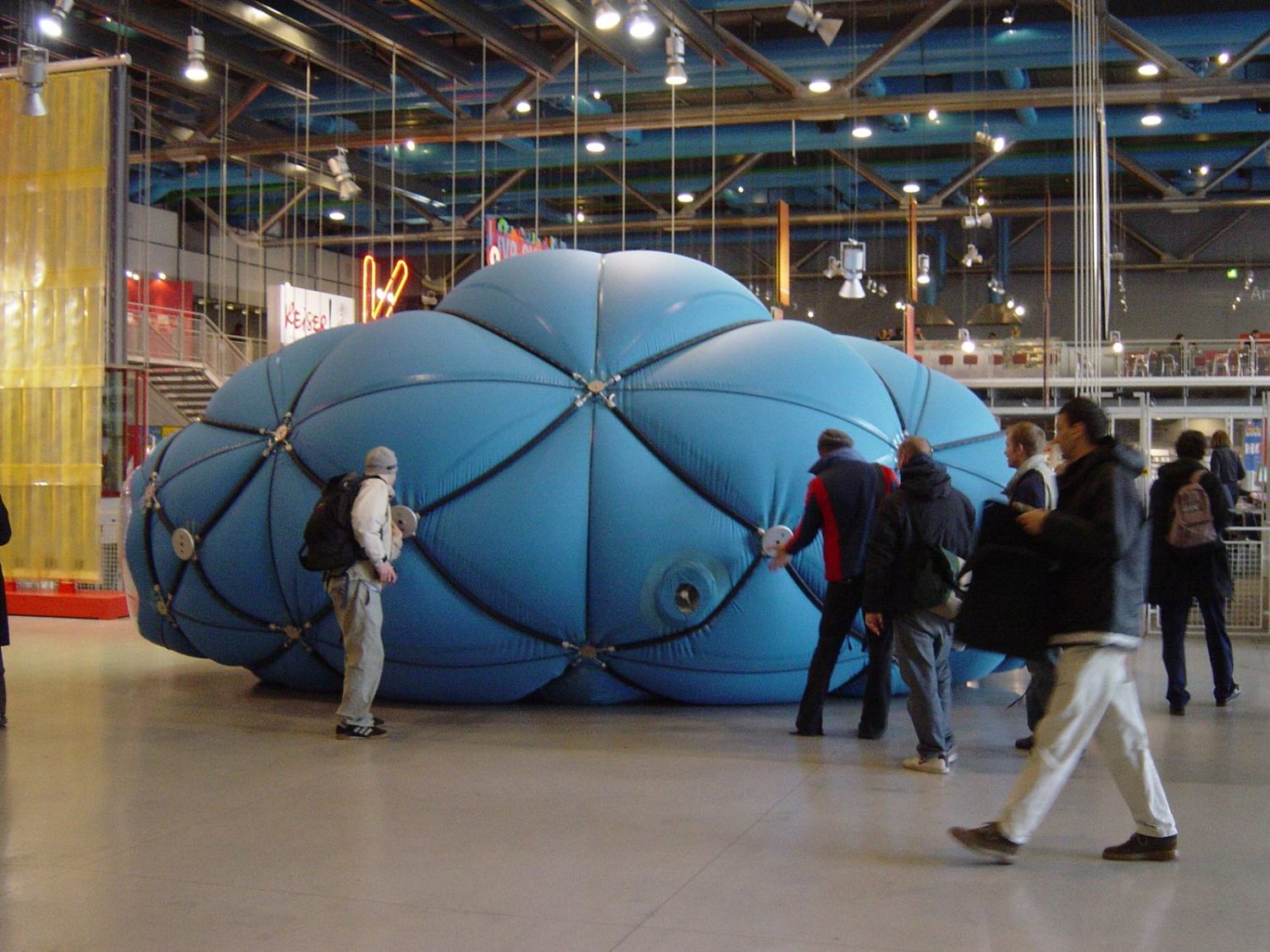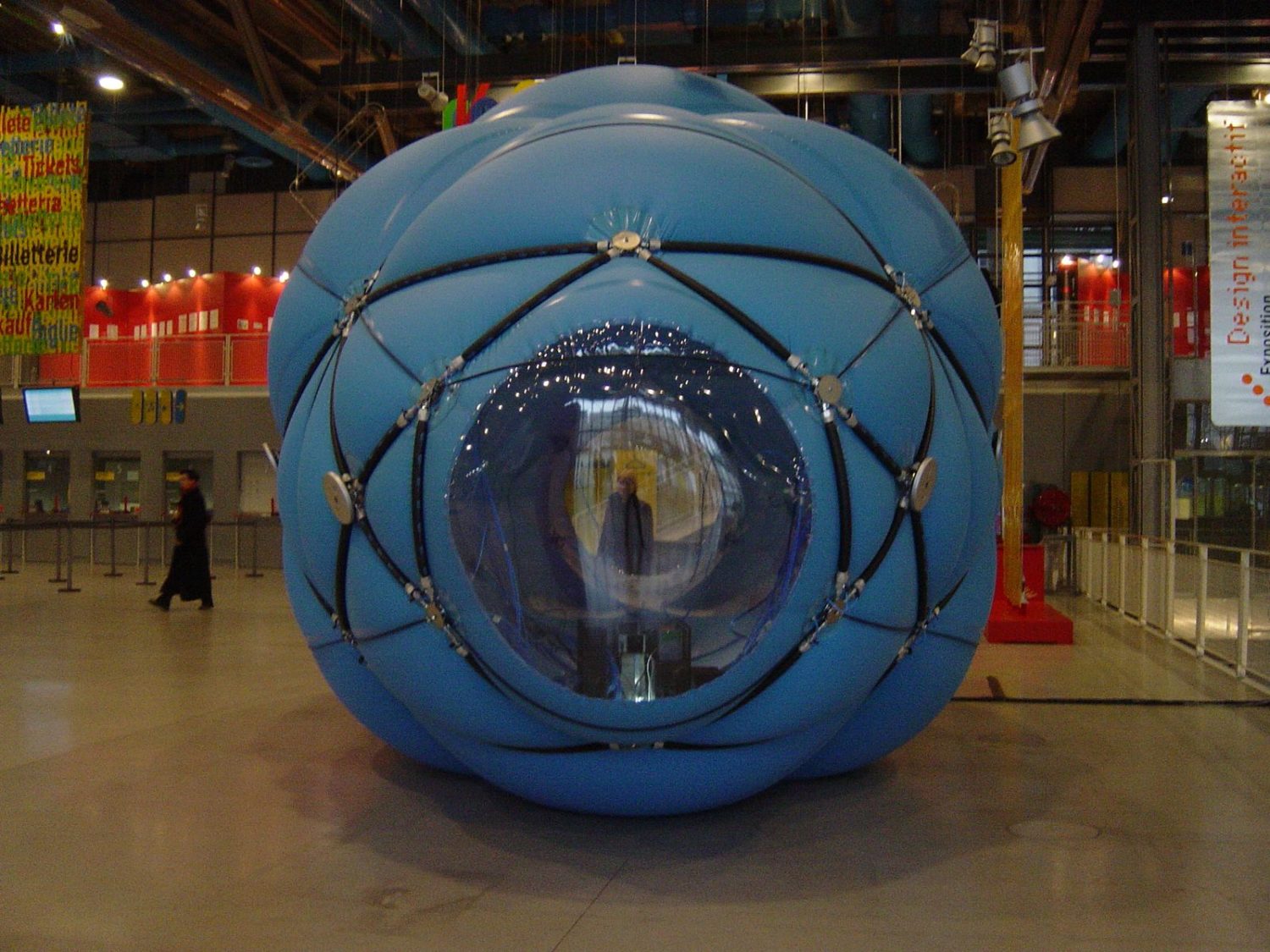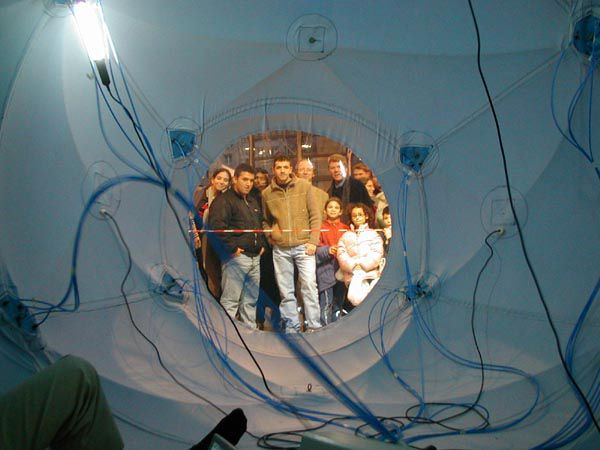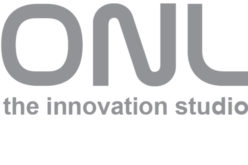The Trans-ports pavilion concept dates back from 1999. The most important feature of the programmable Trans-ports pavilion, which was developed by ONL for a presentation at the first Archilab Conference in Orléans, is that architecture for the first time in history is no longer doomed to remain static after a dynamic design process. This notion formed the basis for a true paradigm shift in architecture at the millennium shift. Due to the programmability of both form and information content the construct becomes a lean and flexible vehicle for a variety of usage. Buildings become instruments, architecture a game designers play with their clients and the users of the built construct.

NSA Muscle at Non Standard Architecture exhibition in Centre Pompidou
For the exhibition Non-Standard Architecture ONL [Oosterhuis_Lénárd bv] [ONL] and the Hyperbody Research Group [HRG] at the TU Delft directed by Prof Kas Oosterhuis realized a working prototype of the Trans-ports project, called the MUSCLE. Programmable buildings can reconfigure themselves mentally and physically, probably without considering to completely displace themselves like the Walking City as proposed by Archigram in 1964. Programmable buildings change shape by contracting and relaxing industrial muscles. The MUSCLE programmable building is a pressurized soft volume wrapped in a mesh of tensile muscles, which change length, height and width by varying the pressure pumped into the muscle. Visitors of the Architectures on Standard exhibition play a collective game to explore he different states of the MUSCLE. The public interacts with the MUSCLE by entering the inter-activated sensorial space surrounding the prototype. This invisible component of the installation is implemented as a sensor field created by a collection of sensors. The sensors create a set of distinct shapes in space that, although invisible to the human eye, can be monitored and can yield information to the building body. The body senses the activities of the people and interacts with the layers in a multimodal way. The public discovers within minutes how the MUSCLE behaves on their actions, and soon after they start finding a goal in the play. The outcome of this interaction however is unpredictable, since the MUSCLE is programmed to have a will of its own. It is pro-active rather then responsive and obedient. The programmable body is played by its users. A constant play of conjointly effectuating (re)actions, of attraction and repulsion between all players involved. This game truly is a multi-player game. Now true communication is established, where the pro-active parties involved alternately sense, process, and actuate in this constant loop of mutual influence. The players experience this parametric game of architecture as a form of serious fun. The design is the formula, the playing of the game means setting the parameters. For the behavioural system this means that the produced sensorial data is analyzed in real-time and acts as the parameters for pre-programmed algorithms and user-driven interferences in the defined scripts. These author-defined behavioural operations are instantly computed, resulting in a diversity of e-motive behaviours that are experienced as changes in the physical shape of the active structure and the generation of an active immersive soundscape.

The MUSCLE really is an interactive input-output device, a play station augmenting itself through time. E-motional filters to specify the mood and the modes of NSA Muscle The MUSCLE is programmed to respond to human visitors through its sensing, processing and actuating enhancements. To communicate with the players, the MUSCLE has to transduce physical quantities into digital signals (sensors) and vice versa (actuators). The public connects to the MUSCLE by sensors attached to reference points on the structure. These input devices convert the behaviour of the human players into data that acts as the parameters for changes in the physical shape of the active structure and the ambient soundscape. The input setup consists of eight sensor plates with three sensors each: motion (for sensing the presence of possible players from a distance of 6 meters), proximity (for sensing the distance of the players to the MUSCLE within a distance of 2 meters) and touch (for sensing the amount of pressure applied upon the surface). The analogue sensor input channels are converted to digital audio signals (MIDI) and transferred to the computer. The 24 sensor impulses, interpreted, processed and weighted by several scripts containing multiple levels of behavioural algorithms, affect the system in a variety of ways. Depending on the active emotional mode the sensor parameters set the actions of the individual muscles. These muscle outputs can be quite diverse between the behavioural modes. Apart from this direct link, a more subtle level is present, being that of input signals also affecting the behavioural state itself. The amount of player/object interactivity is a variable for the complex set of e-motional filters that specify the moods.

NSA Muscle is a pro-active body
The sensorial space surrounding the installation is the interface of the data-driven prototype. The combination of the used sensors gives a smooth gradient of player/object connectivity. Stepping into the invisible playing field one gets detected by the wide ranging beams of motion sensors and through lowres global spatial re-configurations and sound effects ones attention is drawn. Getting curious one wonders what it is this alien body wants from you. While approaching one triggers the proximity beam, a stream of numbers reports exactly how far into the shape one is extending. Local and global skin gestures are displayed and the player indulges with the vehicle. A soundscape arises out of the activities; it feels as if the body itself makes the sounds, as if it is an organism at work. The extended interaction eventually leads to the most intimate action, the physical contact. The touch sensors register the pressure applied and this sensed data results in personalized and player-intended local surface deformation and local sound actions. These surface deformations are the result of the contraction / relaxation of the touch-zone’s neighbouring muscles. When sensors are connected to actuators in a system, then that system is said to be intelligent, i.e. it displays responsive behaviour. But responsiveness is not the goal, since essentially this is just responding to incoming requests. The ultimate goal is pro-activity, meaning that it senses and actuates because some internal force is driving it.
Designers must think and act as programmers
For designing real time constructs it is extremely important that the designer runs and works in the process and not just passively talks about it. Designers must think as a programmers writing code. In the MUSCLE project the design is the code, the designers are the programmers. The programming decisions are the design decisions and visa versa. ONL makes use of game development software since it enables us to quickly and easily create rich, interactive 3D environments operating in real time. It allows any behaviour to react constantly and consistently to its environment, including the user/player. By playing all parties involved (the visitors, the MUSCLE body and the designers) can adjust everything including the code while running the game! This computational design tool allows the user/player to define and completely control the behavioural rules. The MUSCLE is programmed to behave within predefined emotional bandwidths of emotional modes. And within these modes the MUSCLE is free to act and to develop a personal mood. This experienced emotional state of the MUSCLE is the outcome of the e-motive scripts [based on rules, operations and formulas with a multitude of variables] running in real time. Sets of e-motional filters analyse both the incoming sensorial data as well as the inherent data (= the systems output). Being processed and weighted the associated parameters, rules, formulas and arrays are updated, resulting in a different output. The behaviour is at any time a merging of selected global presets and local user interferences, expressed as: Volumetric alterations of the external form, by changing the length (varying the pressure pumped into them) of the tensile muscles To control the behavioural response of the body a balanced pressure-tension combination is applied. Muscles that combined lead to a desired effect [such as skew, taper, bend, twist, shake] are placed into groups, allowing them to contract all at the same time. A series of muscles – the actuators – put together actuate the complex programmable structure in real time. So activation of certain sensors may lead to the bending of to MUSCLE body, while other activations may cause a heavily shaking and vibrating effect. These presets are selected depending on the active mood and related parameters. Presets are not fixed entities; on the contrary, they consist of many parameters [such as frequency, duration, interval, weight]. Combinations and repetitions of these global presets lead to unexpected, surprising and exciting results. This combined with the local user interferences makes the behaviour of the MUSCLE totally unpredictable. The emission of combined pre-designed sounds and at runtime generated wave samples The sound environment receives its data directly from the sensor channels and indirectly from the spatial nodal configuration and the MUSCLE’s behavioural state. Pre-defined and pre-designed sound samples are activated and combined with 36 dynamically created nodal wave samples. The sound properties and samples change on the fly based on the presence of associated sets of variables. This information is combined and passed through a controlling musical behavioural algorithm that generates the ambient soundscape. Physical spatial activities and combinations of sensor activations alter the associated sound parameters directly, resulting in a sophisticated sensual experience. Various base levels build a complex totality (effectuating powers). In combination with the ‘breathing sounds’ of the inflating and deflating muscles an orchestra of ambient sounds fills the space. One really feels the shape of the invisible space. Sound-space and
physical-space become one. A real time graphical display of the computational process A three dimensional visualization of the MUSCLE rendered on a flatscreen informs the public about the nature of this being. This model is the computational process itself. From this model the state of each muscle is determined. The activity of the muscles is displayed in three colors in the model: red / inflating state, blue / deflating state, and gray / passive state, and in the internally used organizational 72 digit string. Also represented in the model are the eight sensor plates changing scale and opacity on activity and the overall behavioural state of the MUSCLE, visualized as a gradual color changing background. Images of practical architectural applications, using muscle technology, complement the graphical display. The real time model is actively viewed from multiple camera positions as to really feel the behavioural patterns at work. Viewed in combination with the actual physical model this graphical interface contributes to the public’s level of understanding.
Text NSA Muscle by Kas Oosterhuis | Project: NSA Muscle | Realisation: December 2003 | Site : Centre Pompidou Paris, Non Standard Architectures exhibition | Design: ONL [Oosterhuis_ Lénárd], Rotterdam | Design team: Kas Oosterhuis, Ilona Lénárd, Bert Bongers, Sven Blokker, Chris Kievid, Remko Siemerink, Laura Aguili | Engineering: ONL, Festo, D3BN, Buitink, Bontron | Client : Mnam-Cci Centre Pompidou Paris
